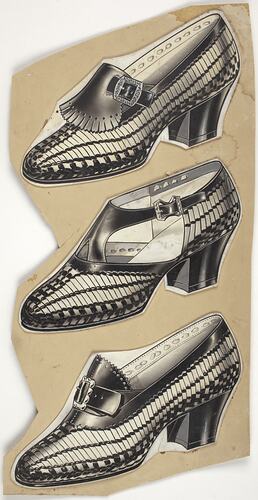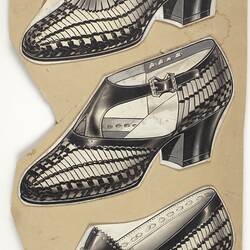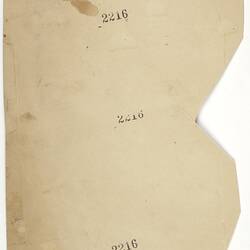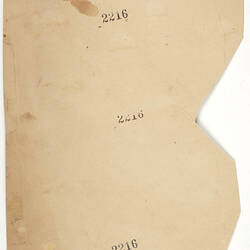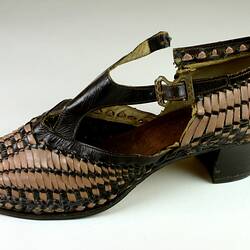Summary
Printer's proof sheet displaying three black and white drawn shoes from Stanio Fancoff's women's basketweave shoe range. Created sometime between the 1930s and 1950s, these proof sheets were most likely used for an advertising leaflet, announcing Stanio's expert skill, diversity but also the attention to detail installed within his shoemaking craft.
Stanio Ivanoff Fancoff was born in 1908 in Bojentsi, a small village in Bulgaria. At age 11, Stanio left home to learn the shoemaking trade. In 1929, he immigrated to Melbourne, settled in Fitzroy and began to work for the V.G. Zemancheff & Sons basket shoe factory in South Melbourne. In1936, he married Dorotea Georgi Touzou who had recently arrived in Australia. Around this time, Stanio set up his own shoemaking business from home, with Georgi, her cousin and sister weaving the shoes which he then assembled. Select shoe samples were then taken to Sydney and Tasmania for sale. In 1942, Georgi and Stanio moved to Broken Hill for Georgi's health; there daughter Nancy was born and Stanio set up a shoe shop/factory. In 1945, Georgi died and by 1950 Stanio and Nancy had moved to Adelaide where he again opened a shoemaking business and shop. He passed away in 1978, having been in the shoemaking business for 59 years. This collection documents his migration and working life experiences.
Physical Description
Placed on a light brown cardboard in a vertical lined format are three women's basketweave shoe image cutouts. These two-dimensional detailed drawings are illustrated from a 45 degree upper viewpoint. Although drawn in black and white, commonly each drawing illustrates the shoe's toe pointing to the left and details the basketweave's different styles and material variations. The top, first shoe is an enclosed style with a fanned leather piece and a large square ornate buckle. The second, is a semi-enclosed shoe whereby it has a heel enclosure but thin straps that hug the ankle, fasten with a small buckle on the left side and create a 'X' shape upon the forefoot's top. The third, bottom positioned shoe is an enclosed slip-on style shoe with a central ornate buckle. The upper right hand cardboard corner appears in a different tone to its counterpart, suggesting possible water damage. On the object's reverse are the thrice inscription, 2216.
Significance
This collection is significant in documenting a small migrant business as well as the fashion of a particular period. It is well provenanced and charts the application of trade skills in a new country. It also illustrates the stages of hand shoe manufacture from the 1930s, demonstrating the enduring nature of the tools and patterns that were used.
More Information
-
Collecting Areas
-
Acquisition Information
Donation from Nancy Vasileff, 21 Mar 2007
-
Past Owner or User
-
Inscriptions
Reverse side, printed, black ink: 2216
-
Classification
-
Category
-
Discipline
-
Type of item
-
Overall Dimensions
143 mm (Width), 308 mm (Height)
-
References
R.A. Salaman, 'Dictionary of Leather-working Tools c.1700-1950 and Tools of Allied Trades,' London: George Allen and Unwin (Publishers) Ltd, 1986 [Section 2: Boot and Shoe Maker pp18-185]. John Peacock. 'Shoes, The Complete Sourcebook,' London:Thames & Hudson Ltd, 2005. NAA holds file (online) on Vasil George Zemancheff, Fancoff's employer
-
Keywords
Boot & Shoemaking, Bulgarian Communities, Bulgarian Immigration, Immigration, Small Businesses
